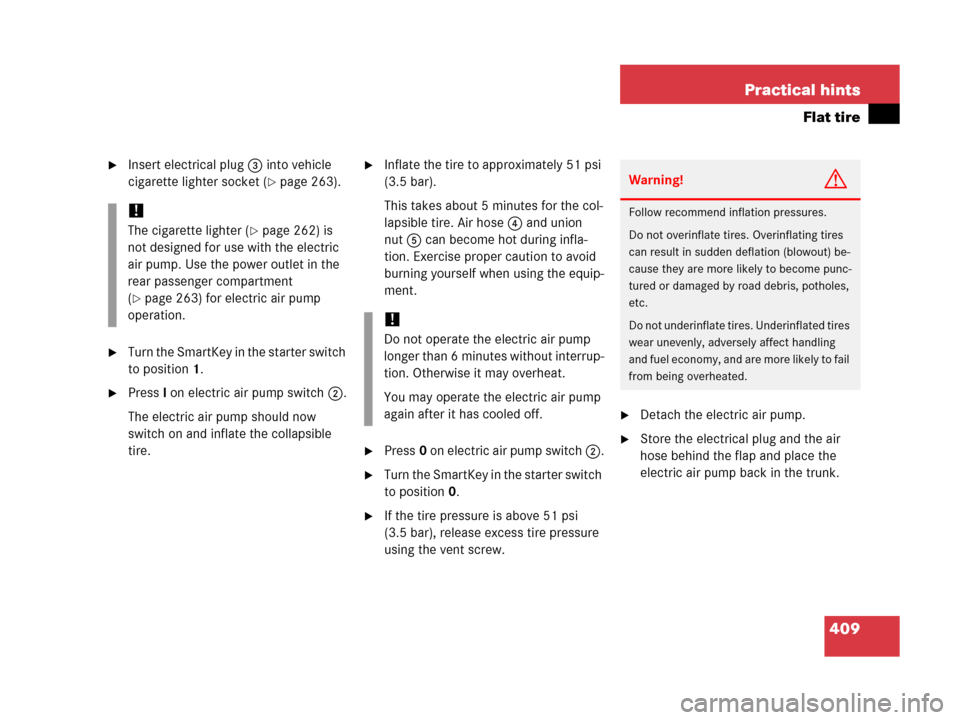Page 294 of 473

293 Operation
At the gas station
�At the gas station
Refueling
The fuel filler flap is located on the
right-hand side of the vehicle towards the
rear. Locking/unlocking the vehicle with
the SmartKey automatically locks/unlocks
the fuel filler flap.1To open the fuel filler flap
2To insert the fuel filler cap
3Supplemental tire inflation pressure
information�Turn the engine off by turning the
SmartKey to position0.
�Remove the SmartKey from the starter
switch.
�Open the fuel filler flap by pushing at
the point indicated by arrow1.
The fuel filler flap springs open.
�Turn fuel cap counterclockwise and
hold on to it until possible pressure is
released.
�Take off cap and set it in direction of
arrow2 in the recess on the fuel filler
flap.
To prevent fuel vapors from escaping
into open air, fully insert filler nozzle
unit.
�Only fill your tank until the filler nozzle
unit cuts out – do not top up or
overfill.
Warning!G
Gasoline is highly flammable and poisonous.
It burns violently and can cause serious
injury. Whenever you are around gasoline,
avoid inhaling fumes and skin contact,
extinguish all smoking materials. Never
allow sparks, flame or smoking materials
near gasoline!
i
In case that the central locking system
does not release the fuel filler flap, or
the opening mechanism is clamping,
notify Roadside Assistance or an au-
thorized Mercedes-Benz Center.
i
Only use premium unleaded gasoline
with a minimum Posted Octane Rating
of 91 (average of 96 RON / 86 MON).
Information on gasoline quality can
normally be found on the fuel pump.
For more information on gasoline, see
“Premium unleaded gasoline”
(
�page 438) or the Factory Approved
Service Products pamphlet.
��
Page 295 of 473
294 Operation
At the gas station
�Replace fuel cap by turning it clockwise
until it audibly engages.
�Close fuel filler flap.
Check regularly and before a long trip
1Coolant
2Brake fluid (fuse box cover removed)
3Windshield washer and headlamp
cleaning system*
Warning!G
Overfilling of the fuel tank may create
pressure in the system which could cause a
gas discharge. This could cause the gas to
spray back out when removing the fuel
pump nozzle, which could cause personal
injury.
i
Leaving the engine running and the fuel
cap open can cause the yellow fuel
tank reserve warning lamp to flash and
theú malfunction indicator lamp
(USA only) or the± malfunction in-
dicator lamp (Canada only) to illumi-
nate.
For more information, see “Practical
hints” (
�page 352) and (�page 353).
i
Opening the hood, see (�page 297).
��
Page 410 of 473

409 Practical hints
Flat tire
�Insert electrical plug 3 into vehicle
cigarette lighter socket (
�page 263).
�Turn the SmartKey in the starter switch
to position1.
�PressI on electric air pump switch 2.
The electric air pump should now
switch on and inflate the collapsible
tire.
�Inflate the tire to approximately 51 psi
(3.5 bar).
This takes about 5 minutes for the col-
lapsible tire. Air hose 4 and union
nut5 can become hot during infla-
tion. Exercise proper caution to avoid
burning yourself when using the equip-
ment.
�Press0 on electric air pump switch 2.
�Turn the SmartKey in the starter switch
to position0.
�If the tire pressure is above 51 psi
(3.5 bar), release excess tire pressure
using the vent screw.
�Detach the electric air pump.
�Store the electrical plug and the air
hose behind the flap and place the
electric air pump back in the trunk.
!
The cigarette lighter (�page 262) is
not designed for use with the electric
air pump. Use the power outlet in the
rear passenger compartment
(
�page 263) for electric air pump
operation.
!
Do not operate the electric air pump
longer than 6 minutes without interrup-
tion. Otherwise it may overheat.
You may operate the electric air pump
again after it has cooled off.
Warning!G
Follow recommend inflation pressures.
Do not overinflate tires. Overinflating tires
can result in sudden deflation (blowout) be-
cause they are more likely to become punc-
tured or damaged by road debris, potholes,
etc.
Do not underinflate tires. Underinflated tires
wear unevenly, adversely affect handling
and fuel economy, and are more likely to fail
from being overheated.